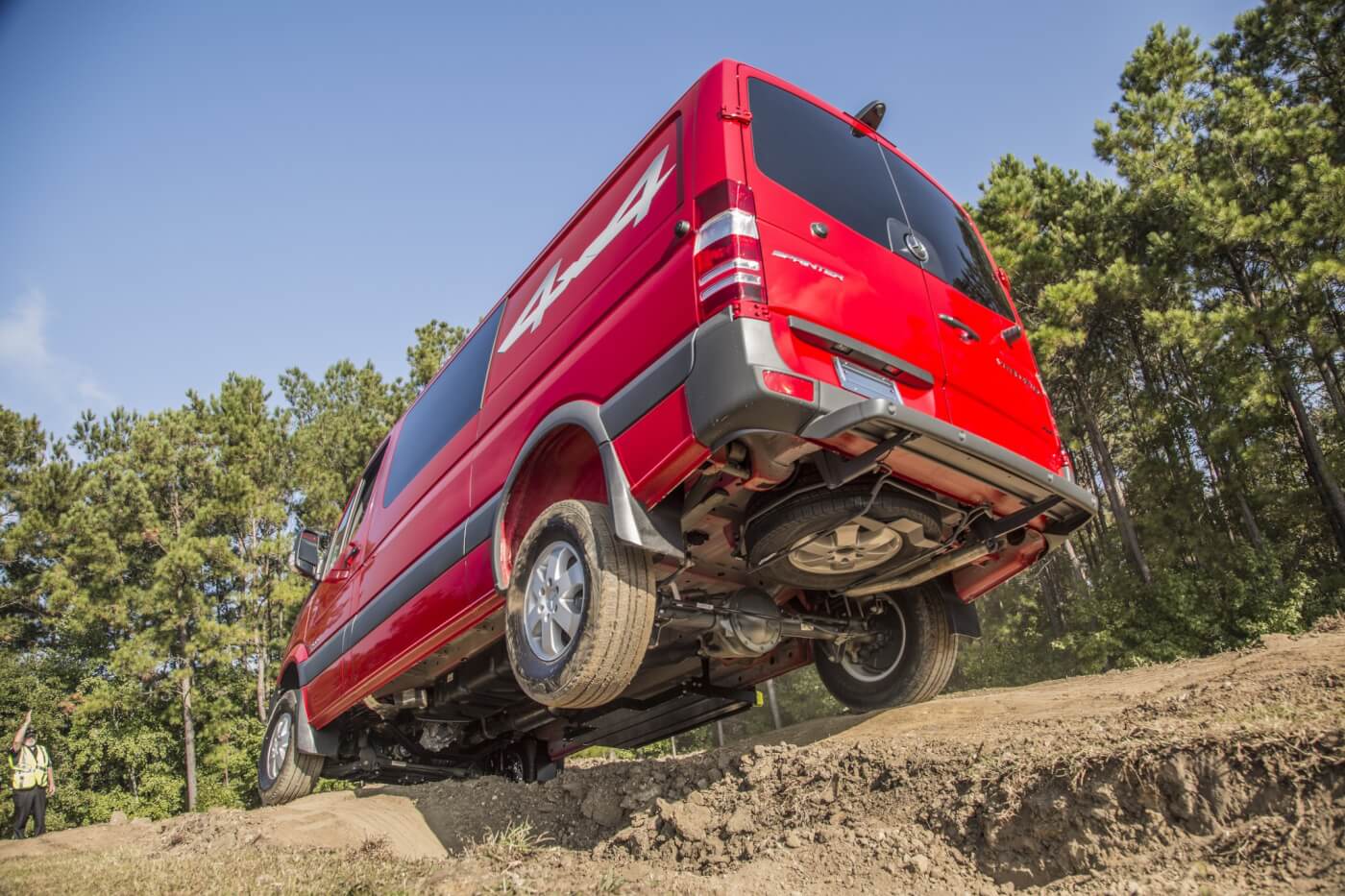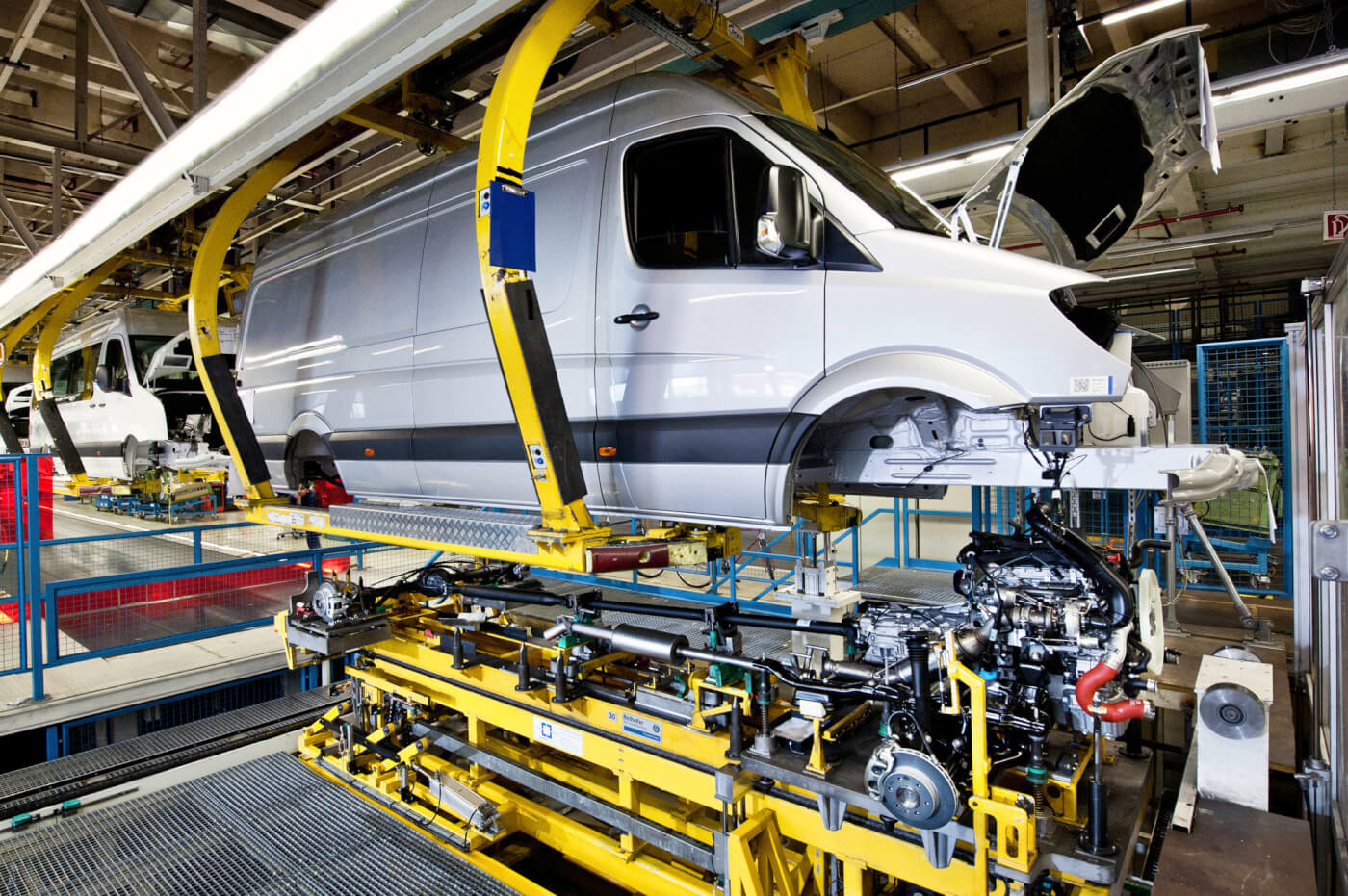2015 Mercedes-Benz Sprinter 4×4
The Mercedes-Benz Sprinter was the first modern European-style van to be sold in the U.S. Mercedes first brought it here in 2001, badged first as a Freightliner and then as a Mercedes (and, for a while, as a Dodge). Nearly a decade and a half later, as Ford and Chrysler are bringing their own Euro-style vans to the U.S., Mercedes has a plan to stay one step ahead: they’re launching a lifted four-wheel-drive version called the Sprinter 4×4.
The Sprinter 4×4 uses an electronically controlled part-time four-wheel-drive system adapted from Mercedes’ SUVs. When 4WD mode is selected, the transfer case distributes 35 percent of the engine’s power to the front axle and 65 percent to the rear. An optional low-range function drops the gearing to increase the Sprinter’s crawling ability. The body is lifted by 4.3 inches at the front and 3.1 inches at the rear, increasing the Sprinter’s approach and break-over angles, though the low clearance of the front independent suspension limits its rock-crawling abilities. The basic suspension setup is identical to the rear-drive van (independent control arms with transverse leaf in front, live axle out back), but the springs, shocks and stabilizer bars have been modified for increased wheel travel.
Mercedes makes it clear that the Sprinter 4×4 is not meant to be an off-road vehicle, but that didn’t stop them from having us try it out on a short off-road course at the Daimler assembly plant in Charleston, South Carolina. We found that the extra body clearance allows the Sprinter to tackle fairly steep slopes, but the limited axle articulation means the van frequently dangles a wheel in the air over uneven terrain. That’s where the Sprinter’s electronic traction control system (called 4ETS) comes in. When the Sprinter stops, all the driver needs to do is feed it more throttle. The system automatically applies the brake on the spinning wheel, distributing power to the other axles to get the van moving again. Strangely, though, the Sprinter 4×4 lacks hill descent control, a feature found in Mercedes SUVs.

Power for the Sprinter 4×4 comes from Mercedes’ 3.0-liter BlueTec V-6 turbo-diesel, tuned for 188 horsepower and 325 lb-ft of torque and connected to a five-speed automatic transmission. Mercedes introduced a 2.1-liter four-cylinder Sprinter last year, but its seven-speed automatic is not compatible with the 4×4 system. (That’s too bad, as the 4-cylinfder gets better fuel economy, and with two extra cogs in the transmission, it accelerates nearly as quickly as the V-6.) Mercedes is offering the 4×4 system as a $6,500 option on the 2015 Sprinter; the low-range gear set costs an additional $300. The 4×4 system is available on both 2500 and 3500 (8,550- and 11,030-lb GVWR) sprinters, with short or long wheelbase (144- or 170-inch), low or high roof, and passenger, cargo and crew configurations.

We’re sure a lot of you are looking at the Sprinter 4×4 and thinking, “How high can she go?” Unfortunately, the answer is not very, at least not without some extensive re-engineering. While the rear axle uses leaf springs, the front end is held up by a composite transverse leaf that is tightly integrated into the front suspension. Larger wheels that fit the Sprinter’s six-lug bolt pattern are difficult to find, and while the body lift provides additional vertical clearance for bigger tires, the wheel openings are still rather narrow.
That said, we think the Sprinter 4×4 will be a useful piece of equipment for owners who have to move people and cargo well off the beaten path. The torquey diesel engine and foolproof 4ETS system makes it easy for inexperienced off-roaders to tackle rough terrain. While it might not be the vehicle of choice for Moab, we think the Sprinter 4×4 will make an excellent all-terrain delivery vehicle, off-road support vehicle, and go-anywhere RV.
How Sprinter Sidesteps the Chicken Tax
Foreign cargo vans are subject to a 25 percent import tariff known as the Chicken Tax, so called because it was created during the Kennedy administration as a response to French and West German taxes on U.S.-sourced chickens. In order to avoid the tax, Mercedes’ parent company Daimler builds U.S.-spec Sprinter cargo vans in Dusseldorf, Germany, then partially disassembles them, removing the wheels, engine, transmission, driveline, suspension, and steering gear, along with the front bumper and grille. The van bodies (with wheels and front-end body work stored inside) are loaded into containers while the mechanical parts are grouped by component type and boxed up, and everything is shipped separately to Daimler’s re-assembly facility in Charleston, South Carolina.
Upon arrival, the bodies are removed from the containers and the mechanical components are unpacked. The van bodies are put on an assembly line where they’re re-united with their mechanical bits and pieces, all of which are marked and bar-coded to ensure they are bolted up to the van on which they were originally installed. Once re-assembled, the vans are aligned, checked for shipping damage, and road-tested on a four-wheel dynamometer. The entire process takes about three hours, with the plant completing around 75 Sprinters per day. Passenger and chassis-cab Sprinters as well as those bound for Canada are not subject to the Chicken Tax, and are shipped whole from Germany. DW










